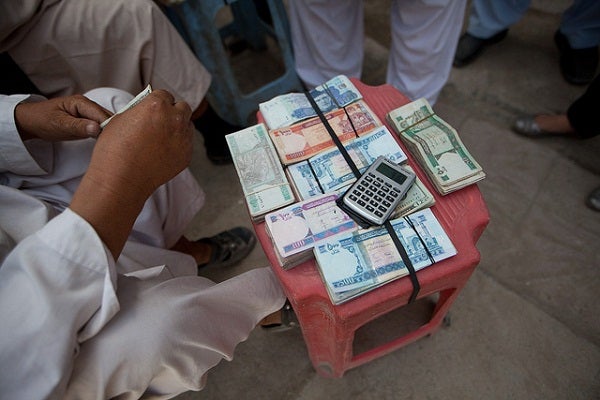Apple Pay in Afghanistan: Could US M-Payments Work Abroad?
Mobile payments may be starting to take off in the United States. Technology companies like Apple, Google and PayPal along with industry clusters like CurrentC and Softcard are jockeying for position – not to mention hundreds of startups from Dwolla to Square. Consumer opinion is shifting. And traditional players are beginning to see innovation as a matter of survival.
But will the United States ever export these developments overseas? Does it even need to? As evidenced by the recent Alibaba Group IPO, the world continues to innovate around – and often without – the United States, which is all-the-more true when it comes to the payments industry. In fact, it’s been argued that mobile payments are a prime example of “reverse innovation” insofar as Western companies can draw inspiration from the hundreds of mobile money deployments overseas, places as far-flung as Bangladesh and Somalia.
So how do these developments relate to one another? Why should someone in Afghanistan care about Apple Pay, and why should someone in Menlo Park care about M-PESA?
Because the fundamental principles and lessons of mobile payments are universal.
 A money changer works in Afghanistan
A money changer works in Afghanistan
Photo Credit: Institute for Money, Technology and Financial Inclusion, via Flickr Creative Commons
When we strip away the nuance, a payment is little more than a trusted agreement and communication between two parties in exchange for a good or service. Both parties place equal value on the means of exchange, trust its authenticity, have confidence in its security, and have faith that that value will remain relatively constant. Neither party cares much about the means of exchange as much as the value it represents.
Using the fundamental principles above, let’s go back to mobile payments, where the primary difference from traditional payment types is form factor and network architecture. Apple Pay, EcoCash, LevelUp, ZAAD, etc. teach us the following lessons:
1) People need a compelling reason to change their behavior. Other than novelty, what value(s) can mobile payment providers offer to create new and lasting behaviors?
Payments alone are not enough. Put simply, people are creatures of habit. We do what we know and what we’re comfortable with, and we’re hesitant to try new things.
Now I can pay by waving my wrist in front of a reader. So what?
Mobile payment providers are trying to answer this and similar questions in different ways. Clinkle and LevelUp in the United States, for instance, are trying to stimulate change through offering loyalty rewards and “treats.” Vodacom M-Pesa in Tanzania offered customers an immediate airtime credit whenever they paid via M-Pesa at eligible merchant locations. Telesom ZAAD in Somaliland and EcoCash in Zimbabwe focused on mitigating the “change problem” for consumers and merchants alike.
2) Building both sides of a two-sided market is hard. Payments is a two-sided market: someone has to issue payment types to consumers and someone has to acquire merchants to accept those payment types. Doing both is a herculean task.
Apple Pay focused on streamlining the consumer experience and partnering with issuing banks from the beginning. By leveraging Near Field Communication (NFC), which was already accepted by hundreds of thousands of merchants, Apple Pay didn’t have to acquire a massive merchant network prior to launching. As a result, it was free to focus on acquiring high-profile merchants like Macy’s and Whole Foods.
In Zimbabwe, EcoCash recently launched a companion card in partnership with MasterCard. By linking with MasterCard, Econet Wireless enabled its customers to transact at more than 47,000,000 merchant locations worldwide – a giant leap from its own network of 10,000+ merchants.
3) Cash isn’t fundamentally broken. Cash may be expensive, filthy and anonymous, but it works. It doesn’t require a charged battery or a 3G connection, it’s universally accepted and it’s frictionless. It’s not going away any time soon. So how can mobile payment providers differentiate their services from cash, which has no minimum payment size and often comes with a discount?
4) Stakeholders have competing incentives. Payment ecosystems have many stakeholders, and their incentives often conflict. Consumers, for instance, may embrace a payment type on the basis of convenience or access to credit, while merchants may scorn it on the basis of fees or delayed cash flow.
Apple Pay aligned itself with consumers and issuing banks, but side-stepped merchants in order to go-to-market quickly. In response, a number of large retailers like CVS and Walmart have rejected Apple Pay in favor of CurrentC, a retailer-led payment network designed to bypass bank cards and associated fees.
5) Transaction fees are disappearing. Transaction fees are being commoditized as new players try to differentiate themselves. Square Cash in the US, for example, lets users send and receive money at no cost. In Kenya, Equitel lets users transfer funds for free as long as both users have an Equity Bank account. Transaction fees are becoming loss leaders – hooks to higher-margin services like loans and new accounts. That said, how will mobile payment providers make money?
Regardless of geography, mobile payment providers face similar challenges and can learn a lot from one another. Will Apple Pay ever roll out in Afghanistan? Probably not. But players in Afghanistan will definitely watch and learn from Apple Pay just like Apple Pay watched and learned from its predecessors.




Add new comment